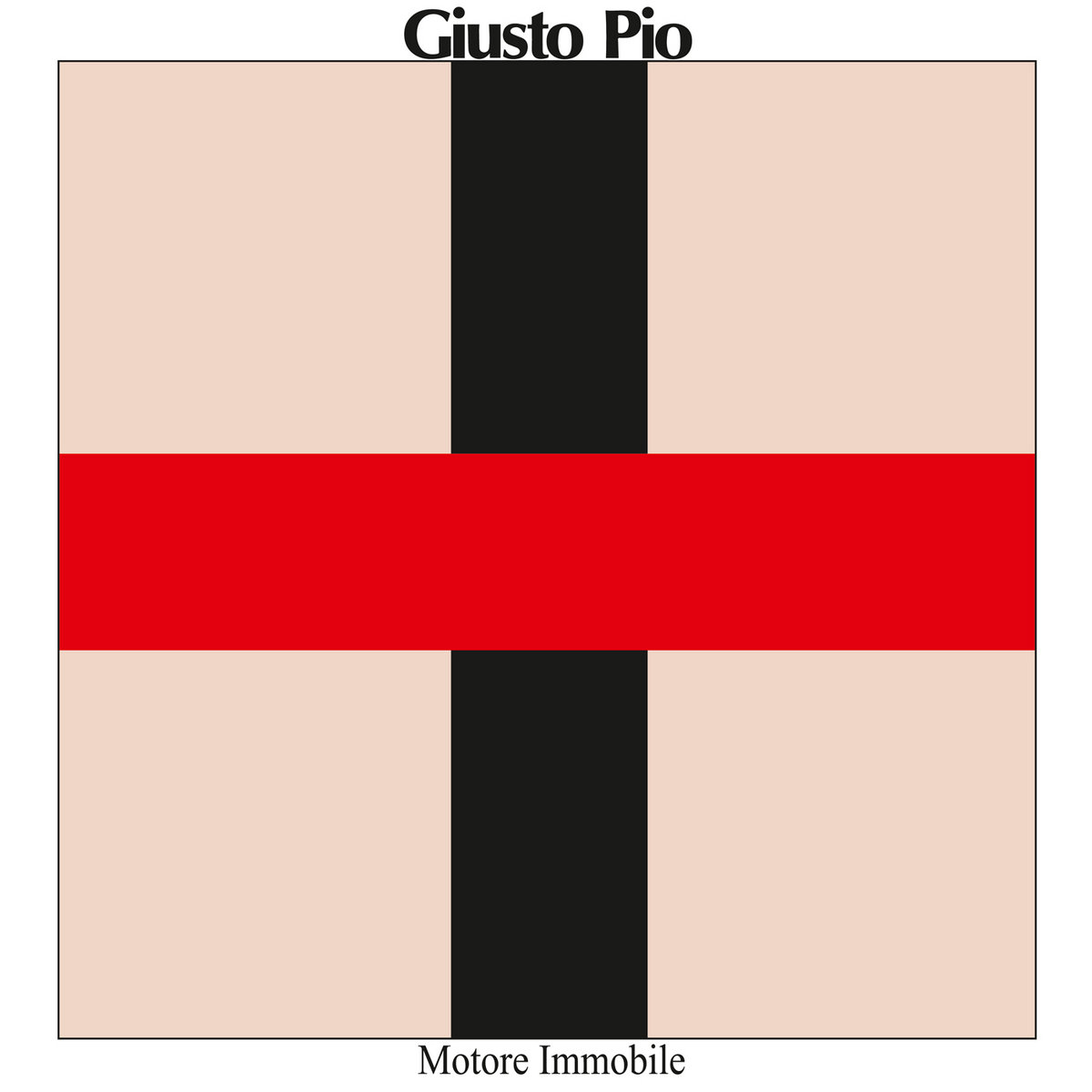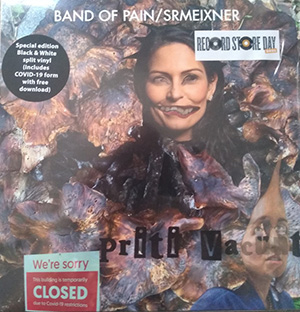 Taking a cue from the politicization of the COVID pandemic, Band of Pain (Steve Pittis) and Contrastate's Stephen Meixner teamed up for this collaborative single, with each taking the lead on a solo piece, and then a balanced collaboration to conclude. Heavily based on samples of speeches and news reports, it is certainly a politically charged work, but one that remains heavily rooted in both artists’ post-industrial and absurdist sensibilities.
Taking a cue from the politicization of the COVID pandemic, Band of Pain (Steve Pittis) and Contrastate's Stephen Meixner teamed up for this collaborative single, with each taking the lead on a solo piece, and then a balanced collaboration to conclude. Heavily based on samples of speeches and news reports, it is certainly a politically charged work, but one that remains heavily rooted in both artists’ post-industrial and absurdist sensibilities.
Band of Pain's "Priti Vacunt" is pretty overt in the target of their ire: UK Home Secretary Priti Patel. A self-described right wing hardliner, Patel was involved in a lobbying scandal around COVID-19 contracts, which is where most of this disgust comes from. The piece itself is a myriad of echoed speech samples and bent electronic tones. The droning, open spaces are unrelentingly bleak, with an insincere sounding sample of “sorry” punctuating the less identifiable moments. In the closing minutes Pittis brings in a thin, distorted rhythmic thump that is all too short.
On the other side of this 10", the Meixner helmed "Deceit" opens up with some pummeling drum programming, but soon the focus is shifted to some American evangelical preacher’s ranting about the disease and vaccination as a noisy, somewhat melodic passage is paraded through. What sounds like even further treated voice samples become an additional element, and Meixner utilizes an intentionally jerky stop/start dynamic throughout. The concluding collaboration "End Result" features less in the way of obvious voice samples but instead fragments of speech or other sounds, pulled apart and reconstructed into something entirely different. The layering is complex and the ambiguity is unsettling, bordering on creepy.
Contemporary political and social criticism aside, the two Steves have created a compelling single that certainly falls in line with their other works as Band of Pain and Contrastate. Idiosyncratic processing, heavily treated samples, noisy outbursts and even the occasional hint of rhythm feature heavily here.  Tempered with just the right amount of black humor (fitting the topic at hand perfectly), the final product reminded me of the unconventional and challenging sample heavy music that was coming out of the UK industrial scene during the mid 1990s (which makes sense given the inception of these projects), but still sounding completely contemporary, nicely hinting at nostalgia while staying modern and fresh.


 Western Massachusetts' loudest deadhead Josh Landes has followed up his live set Unrelenting Barrage of Flowers and Amethyst Energy from last year with a new studio album (well, at 18 minutes, it counts as an album in the noisecore world) that furthers his legacy of intensity and absurdity. Balancing electronic blowouts with creative field recordings, it is another disc of explosive fun.
Western Massachusetts' loudest deadhead Josh Landes has followed up his live set Unrelenting Barrage of Flowers and Amethyst Energy from last year with a new studio album (well, at 18 minutes, it counts as an album in the noisecore world) that furthers his legacy of intensity and absurdity. Balancing electronic blowouts with creative field recordings, it is another disc of explosive fun.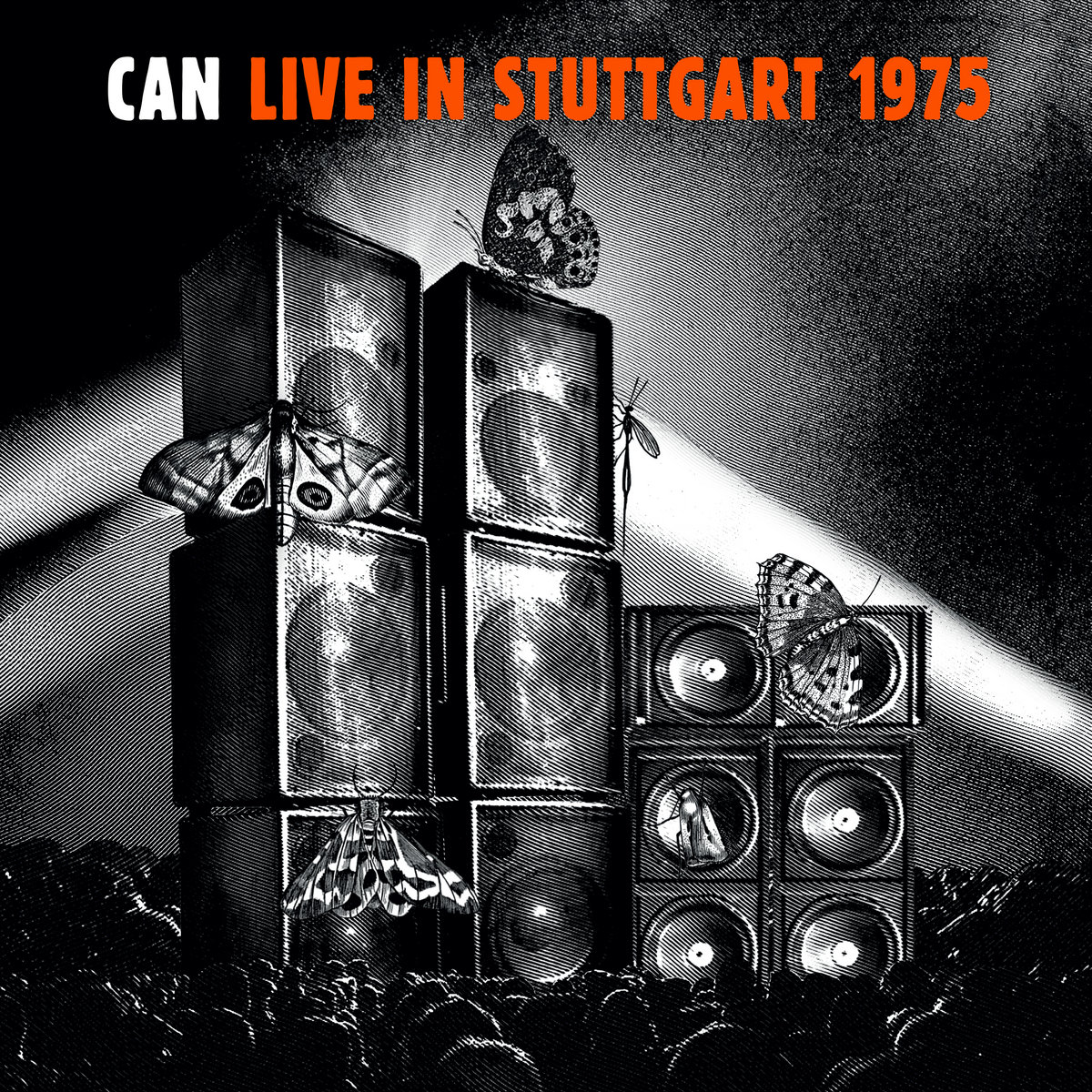 Legendary German kosmiche band Can is not a "hits" band. Despite being known for classic studio work with individual tracks such as "Vitamin C," "Halleluwah," "Mother Sky," and "Future Days," Can, first and foremost, are an improvisational band. While this was a core driver of their studio output, it is particularly evident in their live performances, of which bootlegs of assorted quality exist, noted for never playing a song the same way twice. Singer Damo Suzuki had left the group by this time and Can had released their sixth official studio recording, Landed, an album some fans identify as the marker of Can's slide from greatness. A meticulously produced album, the rock sheen of that studio album could not tell the story of Can's true nature. This polished bootleg — for which we have a devoted fan with large pants to thank — separates the studio mystique from the musicians, showcasing their enduring and practiced talent, revealing the genius of the band's four original members that forever make Can an icon of music history.
Legendary German kosmiche band Can is not a "hits" band. Despite being known for classic studio work with individual tracks such as "Vitamin C," "Halleluwah," "Mother Sky," and "Future Days," Can, first and foremost, are an improvisational band. While this was a core driver of their studio output, it is particularly evident in their live performances, of which bootlegs of assorted quality exist, noted for never playing a song the same way twice. Singer Damo Suzuki had left the group by this time and Can had released their sixth official studio recording, Landed, an album some fans identify as the marker of Can's slide from greatness. A meticulously produced album, the rock sheen of that studio album could not tell the story of Can's true nature. This polished bootleg — for which we have a devoted fan with large pants to thank — separates the studio mystique from the musicians, showcasing their enduring and practiced talent, revealing the genius of the band's four original members that forever make Can an icon of music history.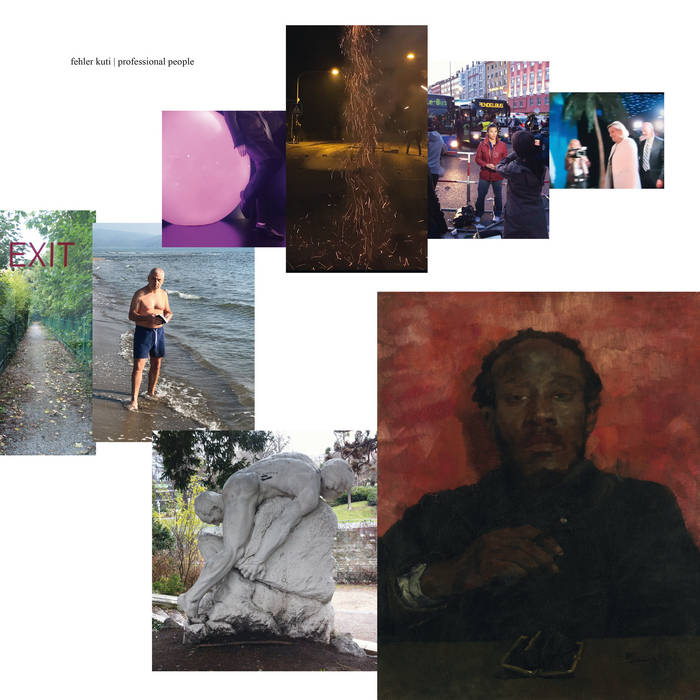 Seeing this release announced as music for "squares" or gated communities, unlikely to appeal to your "woke friends" made me approach it as one might any potential minefield. Learning that Julian Warner, aka Fehler Kuti, is a cultural anthropologist, actor, writer, editor, speaker, art festival curator and producer didn’t lighten the mood much as I feared an onslaught of dry polemic. What a relief then to simply get hooked by these hypnotic tunes - several of which were lullabies for Warner’s newborn child. Professional People reveals as a transcultural concept album, lightly touched with softly spoken wit, 8-bit space jazz, cosmic Euro-pulse, pan, chant, Afro-neon groove, wordless harmony, and melancholic synth. Some of the song titles can act as political signposts, but lyrics are few, mostly oblique, and any message subliminal: hidden in plain sight amid references to bureaucracy, cars, office buildings, home, leisure, gardens, and security. There is no holy indigestible agitprop, no denial of anyone else’s struggle, and Warner leaves academic language and analyses of class, race, and history for the books. He’s razor sharp, but kind, and rather than cutting with words he sprinkles sardonic humor and personal history in with broader observations. The whole record invites everyone to swing along together in our various states of alienated inclusion. Phew. I won’t hear many more enjoyable albums this year.
Seeing this release announced as music for "squares" or gated communities, unlikely to appeal to your "woke friends" made me approach it as one might any potential minefield. Learning that Julian Warner, aka Fehler Kuti, is a cultural anthropologist, actor, writer, editor, speaker, art festival curator and producer didn’t lighten the mood much as I feared an onslaught of dry polemic. What a relief then to simply get hooked by these hypnotic tunes - several of which were lullabies for Warner’s newborn child. Professional People reveals as a transcultural concept album, lightly touched with softly spoken wit, 8-bit space jazz, cosmic Euro-pulse, pan, chant, Afro-neon groove, wordless harmony, and melancholic synth. Some of the song titles can act as political signposts, but lyrics are few, mostly oblique, and any message subliminal: hidden in plain sight amid references to bureaucracy, cars, office buildings, home, leisure, gardens, and security. There is no holy indigestible agitprop, no denial of anyone else’s struggle, and Warner leaves academic language and analyses of class, race, and history for the books. He’s razor sharp, but kind, and rather than cutting with words he sprinkles sardonic humor and personal history in with broader observations. The whole record invites everyone to swing along together in our various states of alienated inclusion. Phew. I won’t hear many more enjoyable albums this year. I initially slept on this album, as the prosaic title made it sound like a collection of old and orphaned songs rather than a minor sound collage masterpiece. The former would be just fine by me (in a non-urgent way), but the fact that this album is actually the latter completely blindsided me. As the label puts it, Collin pulled "shining diamonds from his discography" and put them "in a new context with more recently recorded segments." In more practical terms, this means that the album beautifully bleeds together ephemeral highlights from Collin's discography into a soulfully mesmerizing, endlessly evolving impressionist fantasia. In its most striking moments, Music From Cassettes, Etc. makes me feel like I am a Dickensian ghost experiencing all the warmest moments from Collin's life through a flickering projector.
I initially slept on this album, as the prosaic title made it sound like a collection of old and orphaned songs rather than a minor sound collage masterpiece. The former would be just fine by me (in a non-urgent way), but the fact that this album is actually the latter completely blindsided me. As the label puts it, Collin pulled "shining diamonds from his discography" and put them "in a new context with more recently recorded segments." In more practical terms, this means that the album beautifully bleeds together ephemeral highlights from Collin's discography into a soulfully mesmerizing, endlessly evolving impressionist fantasia. In its most striking moments, Music From Cassettes, Etc. makes me feel like I am a Dickensian ghost experiencing all the warmest moments from Collin's life through a flickering projector. This latest album from Skelton seems intended to be a major new statement, though not quite a formal follow-up to last year's These Charms May be Sung Over a Wound, as double LPs are a real rarity in the prolific composer's discography. If it was not intended as such, it certainly has the ambitious conceptual framework and focused power of his strongest work. For these four pieces, Skelton used a self-devised divination deck of Proto-Indo-European word roots for inspiration, making the album the fruit of an occult-tinged and antiquarian word game. Skelton also maintained the same restricted palette and duration for each piece, yet the tone varies significantly between them, as he treated each composition as a meditation upon a single, unvoiced question. To some degree, Four Workings is an especially ambient-minded release, as the hypnotically repeating melodic fragments are reminiscent of Celer's most loop-driven fare. The similarities mostly end there, however, as the billowing ambiance is often a smokescreen for a more sharp-edged and sophisticated undercurrent that slowly emerges from the murky depths. This is an unusually strong suite of compositions for Skelton's current phase, and the first piece in particular is probably among his finest moments to date.
This latest album from Skelton seems intended to be a major new statement, though not quite a formal follow-up to last year's These Charms May be Sung Over a Wound, as double LPs are a real rarity in the prolific composer's discography. If it was not intended as such, it certainly has the ambitious conceptual framework and focused power of his strongest work. For these four pieces, Skelton used a self-devised divination deck of Proto-Indo-European word roots for inspiration, making the album the fruit of an occult-tinged and antiquarian word game. Skelton also maintained the same restricted palette and duration for each piece, yet the tone varies significantly between them, as he treated each composition as a meditation upon a single, unvoiced question. To some degree, Four Workings is an especially ambient-minded release, as the hypnotically repeating melodic fragments are reminiscent of Celer's most loop-driven fare. The similarities mostly end there, however, as the billowing ambiance is often a smokescreen for a more sharp-edged and sophisticated undercurrent that slowly emerges from the murky depths. This is an unusually strong suite of compositions for Skelton's current phase, and the first piece in particular is probably among his finest moments to date.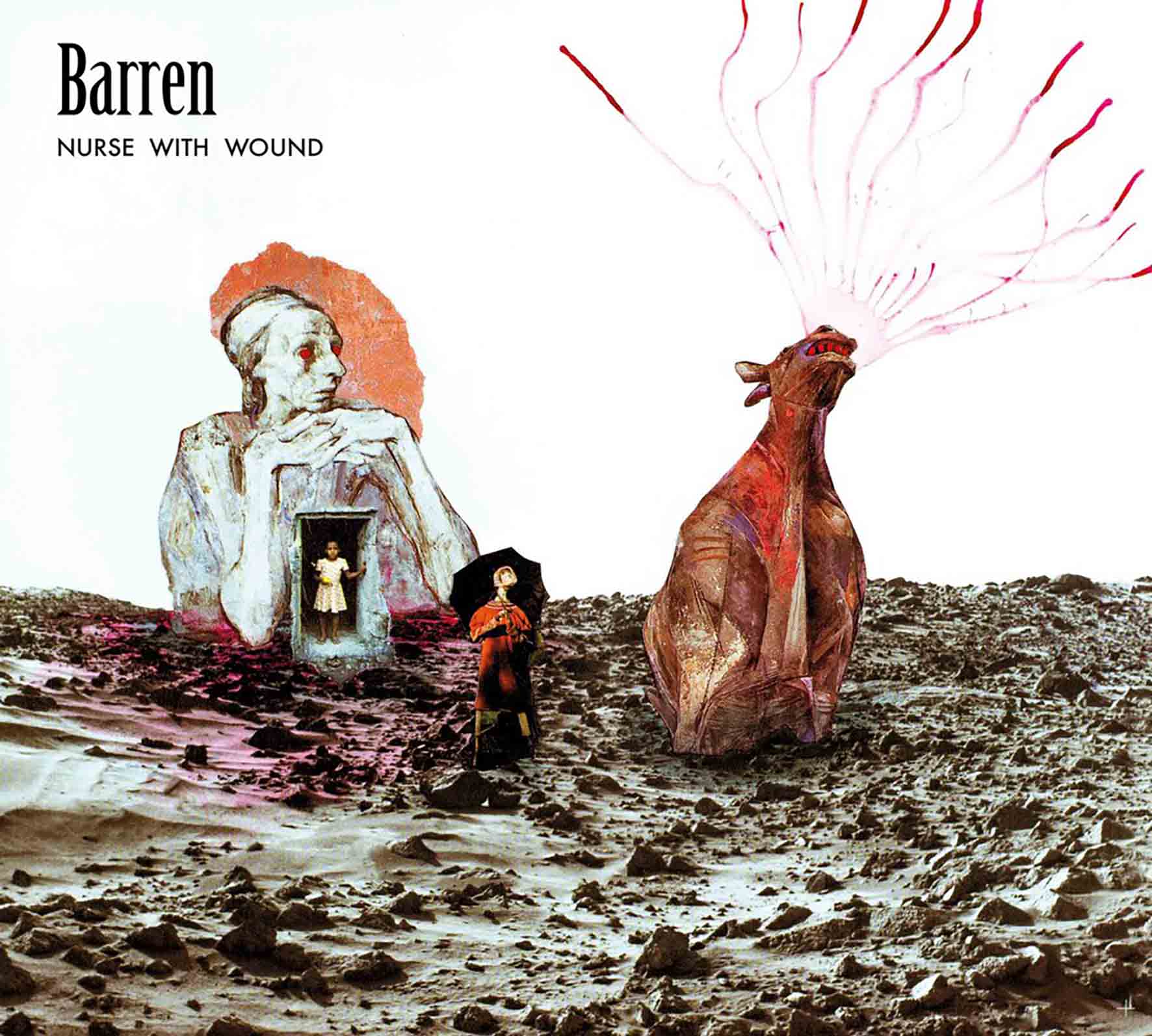 This double album had the misfortune of being released near the end of 2020, so it lamentably did not quite get the attention that it deserved (and being a live album probably did not help matters much either).  Granted, it has admittedly been a while since the NWW camp dropped an album that I would breathlessly proclaim a stone-cold masterpiece, yet the project's current era features quite a formidable lineup. In fact, most United Dairies/ICR releases in recent years have been refreshingly solid for an entity with such a vast and historically erratic discography. Barren happily continues that trend, documenting two performances from differing lineup configurations that have been deemed "amongst their most unusual performances." In this context, however, "unusual" means "very professional-sounding longform works conspicuously free of sinister whimsy." Significantly, the two performances are almost unrecognizable as NWW despite cannibalizing a pair of studio releases. They make for quite a satisfying deep-psych/spaced-out ambient release in their own right, however, as there is no rule stating that albums need to be representative to be enjoyable.
This double album had the misfortune of being released near the end of 2020, so it lamentably did not quite get the attention that it deserved (and being a live album probably did not help matters much either).  Granted, it has admittedly been a while since the NWW camp dropped an album that I would breathlessly proclaim a stone-cold masterpiece, yet the project's current era features quite a formidable lineup. In fact, most United Dairies/ICR releases in recent years have been refreshingly solid for an entity with such a vast and historically erratic discography. Barren happily continues that trend, documenting two performances from differing lineup configurations that have been deemed "amongst their most unusual performances." In this context, however, "unusual" means "very professional-sounding longform works conspicuously free of sinister whimsy." Significantly, the two performances are almost unrecognizable as NWW despite cannibalizing a pair of studio releases. They make for quite a satisfying deep-psych/spaced-out ambient release in their own right, however, as there is no rule stating that albums need to be representative to be enjoyable. This mesmerizing and unique gem from Sublime Frequencies documents some killer field recordings made by Hisham Mayet in the Upper West region of Ghana back in 2019. I knew absolutely nothing about gyril music before hearing this album, but the most salient detail is that the primary instrument is a traditional xylophone used by the Lobi people. That does not even remotely convey how strange and wonderful these recordings are, but SF's description includes phrases like "long form trance music" and "acoustic techno," and those seem to hit the mark in spirit. To me, this album sounds like a ritualistic drum circle, but way more sophisticated, melodic, and psych-damaged than anything I would expect from actual communal percussion. As with a lot of field-recorded Sublime Frequency fare, it is very easy to dismiss this album as just an interesting window into an underheard culture from a cursory or casual listen. Once I listened to Dagara in a focused way, however, it quickly revealed itself to be something quite transcendent, as it seamlessly merges the otherness of great "experimental" music with an almost ecstatic visceral intensity.
This mesmerizing and unique gem from Sublime Frequencies documents some killer field recordings made by Hisham Mayet in the Upper West region of Ghana back in 2019. I knew absolutely nothing about gyril music before hearing this album, but the most salient detail is that the primary instrument is a traditional xylophone used by the Lobi people. That does not even remotely convey how strange and wonderful these recordings are, but SF's description includes phrases like "long form trance music" and "acoustic techno," and those seem to hit the mark in spirit. To me, this album sounds like a ritualistic drum circle, but way more sophisticated, melodic, and psych-damaged than anything I would expect from actual communal percussion. As with a lot of field-recorded Sublime Frequency fare, it is very easy to dismiss this album as just an interesting window into an underheard culture from a cursory or casual listen. Once I listened to Dagara in a focused way, however, it quickly revealed itself to be something quite transcendent, as it seamlessly merges the otherness of great "experimental" music with an almost ecstatic visceral intensity. 1988's Love Hysteria was my introduction to Peter Murphy as a solo artist, likely initiated by MTV's 120 Minutes airplay of "All Night Long." A minor hit in the United States, this and a host of other strong tracks from Murphy's second solo release would see Murphy exposed to a renewed audience as a solo performer, those both unfamiliar and familiar with his back catalog. Some of this may be attributable to the start of Murphy's songwriting collaboration with Paul Statham (ex B-Movie). This fruitful union would see the two working together for another six albums, producing some of his best-loved works over the next few years. This work alone spawned the aforementioned "All Night Long" as well as masterworks "Indigo Eyes," "Dragnet Drag," and "Blind Sublime."
1988's Love Hysteria was my introduction to Peter Murphy as a solo artist, likely initiated by MTV's 120 Minutes airplay of "All Night Long." A minor hit in the United States, this and a host of other strong tracks from Murphy's second solo release would see Murphy exposed to a renewed audience as a solo performer, those both unfamiliar and familiar with his back catalog. Some of this may be attributable to the start of Murphy's songwriting collaboration with Paul Statham (ex B-Movie). This fruitful union would see the two working together for another six albums, producing some of his best-loved works over the next few years. This work alone spawned the aforementioned "All Night Long" as well as masterworks "Indigo Eyes," "Dragnet Drag," and "Blind Sublime." This collection of (mostly) acapella field recordings from Kink Gong's Laurent Jeanneau truly emphasizes the "sublime" part of the Sublime Frequencies vision, as this is quite an eerily lovely and mesmerizing album. While the recordings span three different countries (China, Laos, and Vietnam), they are all roughly rooted in a single cultural milieu: the Chinese hill tribes known pejoratively as the Yao ("dog" or "savage"). Understandably, a large number of these tribal folk prefer the name Mien ("people"), but they are a multifarious bunch that have spread beyond China into Southeast Asia and evolved into numerous distinctive and divergent subcultures. The first half of the album is devoted to very pure and simple canon singing ("an initial melody is imitated at a specified time interval by one or more parts"), while the second half offers some compelling and more fleshed-out variations. While the "raw, ethereal, and cosmic" performances that Laurent captured need no additional enhancement to captivate me, the variations are every bit as great as the undiluted essence and give the album an impressively strong dynamic arc.
This collection of (mostly) acapella field recordings from Kink Gong's Laurent Jeanneau truly emphasizes the "sublime" part of the Sublime Frequencies vision, as this is quite an eerily lovely and mesmerizing album. While the recordings span three different countries (China, Laos, and Vietnam), they are all roughly rooted in a single cultural milieu: the Chinese hill tribes known pejoratively as the Yao ("dog" or "savage"). Understandably, a large number of these tribal folk prefer the name Mien ("people"), but they are a multifarious bunch that have spread beyond China into Southeast Asia and evolved into numerous distinctive and divergent subcultures. The first half of the album is devoted to very pure and simple canon singing ("an initial melody is imitated at a specified time interval by one or more parts"), while the second half offers some compelling and more fleshed-out variations. While the "raw, ethereal, and cosmic" performances that Laurent captured need no additional enhancement to captivate me, the variations are every bit as great as the undiluted essence and give the album an impressively strong dynamic arc.
 This second album from Milan-based visual artist/electro-acoustic composer Domiziano Maselli can be a disorienting collision of disparate inspirations at times, but it is certainly an intensely visceral and compelling experience when it hits the mark. Opal's description of the album mentions that Maselli possesses an "uncanny skill to create non-conformist drama," which feels like an apt characterization. It is similarly fair to say that Maselli likely has an extreme fondness for the gloomy prime of artists like Haxan Cloak and Raime, as well as a deep appreciation for Emptyset's seismic and intense approach to sound design. Elements of all three are certainly present on Lazzaro, though Maselli proves quite adept at building upon their best bits. That said, there are also a few pieces that radically break from the influences Maselli wears on his sleeve and they are uniformly brilliant. In one case, he approximates a massive contraption of slowly whirling jagged, rusted metal blades, while elsewhere he unleashes something akin to a demonically possessed string quartet hellbent on conjuring the darkest psychedelia. For me, Lazarro is a very strong album for those two pieces alone, but his execution for everything else is quite impressive as well.
This second album from Milan-based visual artist/electro-acoustic composer Domiziano Maselli can be a disorienting collision of disparate inspirations at times, but it is certainly an intensely visceral and compelling experience when it hits the mark. Opal's description of the album mentions that Maselli possesses an "uncanny skill to create non-conformist drama," which feels like an apt characterization. It is similarly fair to say that Maselli likely has an extreme fondness for the gloomy prime of artists like Haxan Cloak and Raime, as well as a deep appreciation for Emptyset's seismic and intense approach to sound design. Elements of all three are certainly present on Lazzaro, though Maselli proves quite adept at building upon their best bits. That said, there are also a few pieces that radically break from the influences Maselli wears on his sleeve and they are uniformly brilliant. In one case, he approximates a massive contraption of slowly whirling jagged, rusted metal blades, while elsewhere he unleashes something akin to a demonically possessed string quartet hellbent on conjuring the darkest psychedelia. For me, Lazarro is a very strong album for those two pieces alone, but his execution for everything else is quite impressive as well.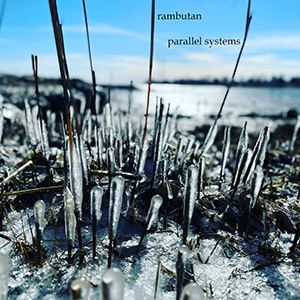 As his primary (and solo) project, Albany’s Eric Hardiman's Rambutan is always in flux. Some of his many other projects are a bit more predictable: Sky Furrows is 1980s indie noise rock inspired, Spiral Wave Nomads is more free improvisation, etc., but Rambutan has always been something different. Sometimes the work is harsher, other times more subdued and atmospheric, and instrumentation can very significantly from release to release. For this more conceptually album, there is even less predictability. Featuring 69 contributing artists across 33 pieces and over two and a half hours in length, it is fully encompassing of Hardiman’s body of work, solo and in collaboration with others, and reiterates what a multifaceted and gifted artist and performer he is.
As his primary (and solo) project, Albany’s Eric Hardiman's Rambutan is always in flux. Some of his many other projects are a bit more predictable: Sky Furrows is 1980s indie noise rock inspired, Spiral Wave Nomads is more free improvisation, etc., but Rambutan has always been something different. Sometimes the work is harsher, other times more subdued and atmospheric, and instrumentation can very significantly from release to release. For this more conceptually album, there is even less predictability. Featuring 69 contributing artists across 33 pieces and over two and a half hours in length, it is fully encompassing of Hardiman’s body of work, solo and in collaboration with others, and reiterates what a multifaceted and gifted artist and performer he is.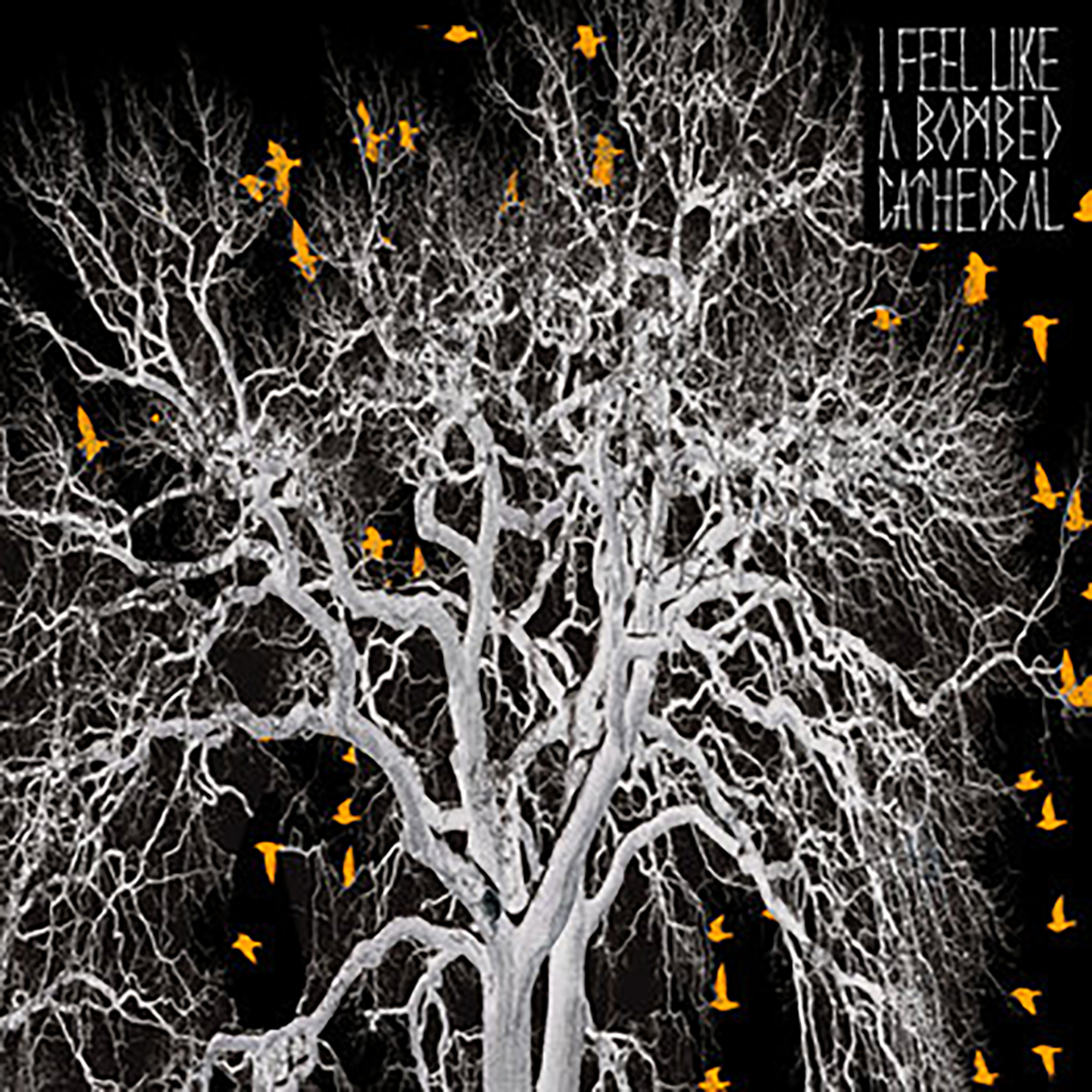 This solo drone project from Ulan Bator's Amaury Cambuzat has been one of my favorite discoveries of the last few years, as both AmOrtH and W featured moments that induced me to proclaim that Cambuzat was "a goddamn drone shaman." This latest album was a bit of a surprise, however, as Cambuzat casually made it available as a digital-only release on his Bandcamp page with just a simple description of "This is the very first recording of I Feel Like a Bombed Cathedral." Apparently, the recordings date from early 2018 and I am amazed that Cambuzat did not feel inclined to make them public until now, as a handful of these pieces are absolute gems that rank among the project’s finest work. A few of the other ones admittedly feel like a searching, partially formed vision of the greatness to come, but γένεσις is much, much better than its humble "vault clearing" origins suggest. I would not have been at all disappointed if this was a proper new Bombed Cathedral release, as the album is absolutely teaming with beautifully warped guitar sounds and immersive layers of richly textured psychedelia. In fact, γένεσις only heightens my expectations for whatever Cambuzat might be working on now, as no sane person would keep music this great on the shelf for three years unless they had something even better in the pipeline.
This solo drone project from Ulan Bator's Amaury Cambuzat has been one of my favorite discoveries of the last few years, as both AmOrtH and W featured moments that induced me to proclaim that Cambuzat was "a goddamn drone shaman." This latest album was a bit of a surprise, however, as Cambuzat casually made it available as a digital-only release on his Bandcamp page with just a simple description of "This is the very first recording of I Feel Like a Bombed Cathedral." Apparently, the recordings date from early 2018 and I am amazed that Cambuzat did not feel inclined to make them public until now, as a handful of these pieces are absolute gems that rank among the project’s finest work. A few of the other ones admittedly feel like a searching, partially formed vision of the greatness to come, but γένεσις is much, much better than its humble "vault clearing" origins suggest. I would not have been at all disappointed if this was a proper new Bombed Cathedral release, as the album is absolutely teaming with beautifully warped guitar sounds and immersive layers of richly textured psychedelia. In fact, γένεσις only heightens my expectations for whatever Cambuzat might be working on now, as no sane person would keep music this great on the shelf for three years unless they had something even better in the pipeline.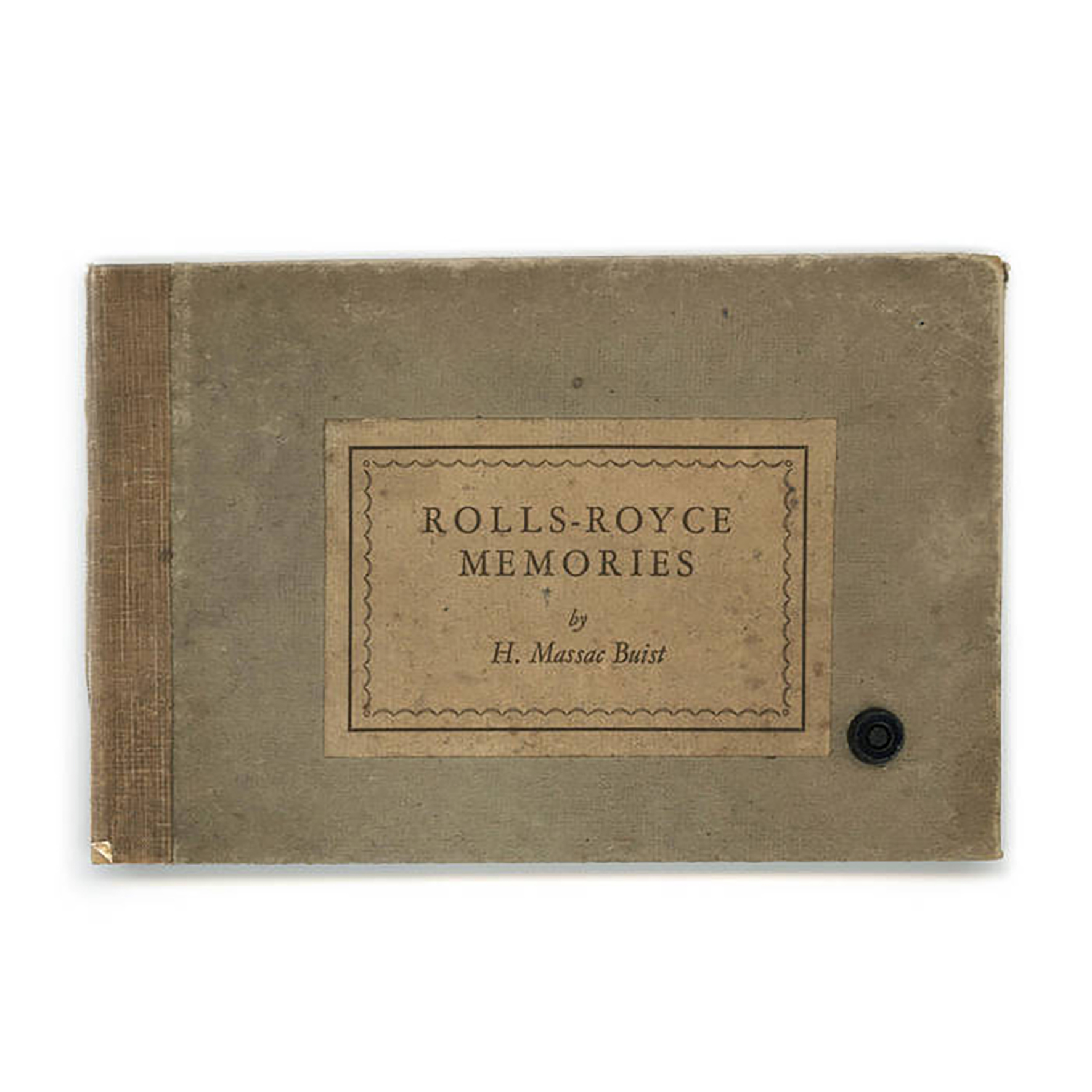 It admittedly took me a while to finally connect all the dots in my head, but it dawned on me recently that The Boats were kind of the Throbbing Gristle of a hard-to-define strain of ambient-adjacent bittersweet melancholia. My case: both Andrew Hargreaves and/or Craig Tattersall have been consistently involved in a host of varied and wonderful projects for more than two decades now (Hood, The Remote Viewer, Tape Loop Orchestra, etc.). The tape loop-focused The Humble Bee is Tattersall's most prolific and consistent endeavor; he has been releasing solo work and collaborations under that moniker since 2009. In fact, this album was the project's debut, but I only recently heard it for the first time, as its initial release was a limited CDr in a handmade case made from repurposed book covers (pictured). Last month, it got a well-deserved reissue on vinyl from the endearingly eccentric Astral Industries with VERY different cover art and it sold out instantly. That gives me hope for humanity, as this incredibly beautiful and absolutely sublime release deserves as much exposure as it can get. A Miscellany for the Quiet Hours is a stone-cold classic.
It admittedly took me a while to finally connect all the dots in my head, but it dawned on me recently that The Boats were kind of the Throbbing Gristle of a hard-to-define strain of ambient-adjacent bittersweet melancholia. My case: both Andrew Hargreaves and/or Craig Tattersall have been consistently involved in a host of varied and wonderful projects for more than two decades now (Hood, The Remote Viewer, Tape Loop Orchestra, etc.). The tape loop-focused The Humble Bee is Tattersall's most prolific and consistent endeavor; he has been releasing solo work and collaborations under that moniker since 2009. In fact, this album was the project's debut, but I only recently heard it for the first time, as its initial release was a limited CDr in a handmade case made from repurposed book covers (pictured). Last month, it got a well-deserved reissue on vinyl from the endearingly eccentric Astral Industries with VERY different cover art and it sold out instantly. That gives me hope for humanity, as this incredibly beautiful and absolutely sublime release deserves as much exposure as it can get. A Miscellany for the Quiet Hours is a stone-cold classic. Back in 2016, noise/sound art legend Joe Colley returned from a lengthy hiatus to release the solid No Way In on Jason Lescalleet's Glistening Examples, but he has been extremely quiet ever since, surfacing only to release a tape of a durational live performance last year. Happily, he is back again with another major statement and it is quite a monster. It is also unusually accessible at times, as Trance Tapes lives up to its name beautifully (though those trances inevitably curdle into nightmare territory). In some ways, this album resembles a classic noise tape on the more "industrial" side of the spectrum, as each of the four pieces is built from a foundation of relentless, obsessively repeating "machine-noise" to varying degrees. That is merely the starting point, however, as each piece rapidly blossoms into a vividly psychotropic mindbomb of viscerally buzzing frequencies and hypnotically repeating chirps, bleeps, throbs, and looping drones. I suspect many serious noise fans would roll their eyes or spit out their drink in disbelief if I had the temerity to proclaim this a career highlight, so I will refrain from doing that. However, it is extremely difficult to imagine a Joe Colley or Crawl Unit album in which he was able to realize his vision with more clarity and focus than he does with this near-perfect tour de force.
Back in 2016, noise/sound art legend Joe Colley returned from a lengthy hiatus to release the solid No Way In on Jason Lescalleet's Glistening Examples, but he has been extremely quiet ever since, surfacing only to release a tape of a durational live performance last year. Happily, he is back again with another major statement and it is quite a monster. It is also unusually accessible at times, as Trance Tapes lives up to its name beautifully (though those trances inevitably curdle into nightmare territory). In some ways, this album resembles a classic noise tape on the more "industrial" side of the spectrum, as each of the four pieces is built from a foundation of relentless, obsessively repeating "machine-noise" to varying degrees. That is merely the starting point, however, as each piece rapidly blossoms into a vividly psychotropic mindbomb of viscerally buzzing frequencies and hypnotically repeating chirps, bleeps, throbs, and looping drones. I suspect many serious noise fans would roll their eyes or spit out their drink in disbelief if I had the temerity to proclaim this a career highlight, so I will refrain from doing that. However, it is extremely difficult to imagine a Joe Colley or Crawl Unit album in which he was able to realize his vision with more clarity and focus than he does with this near-perfect tour de force.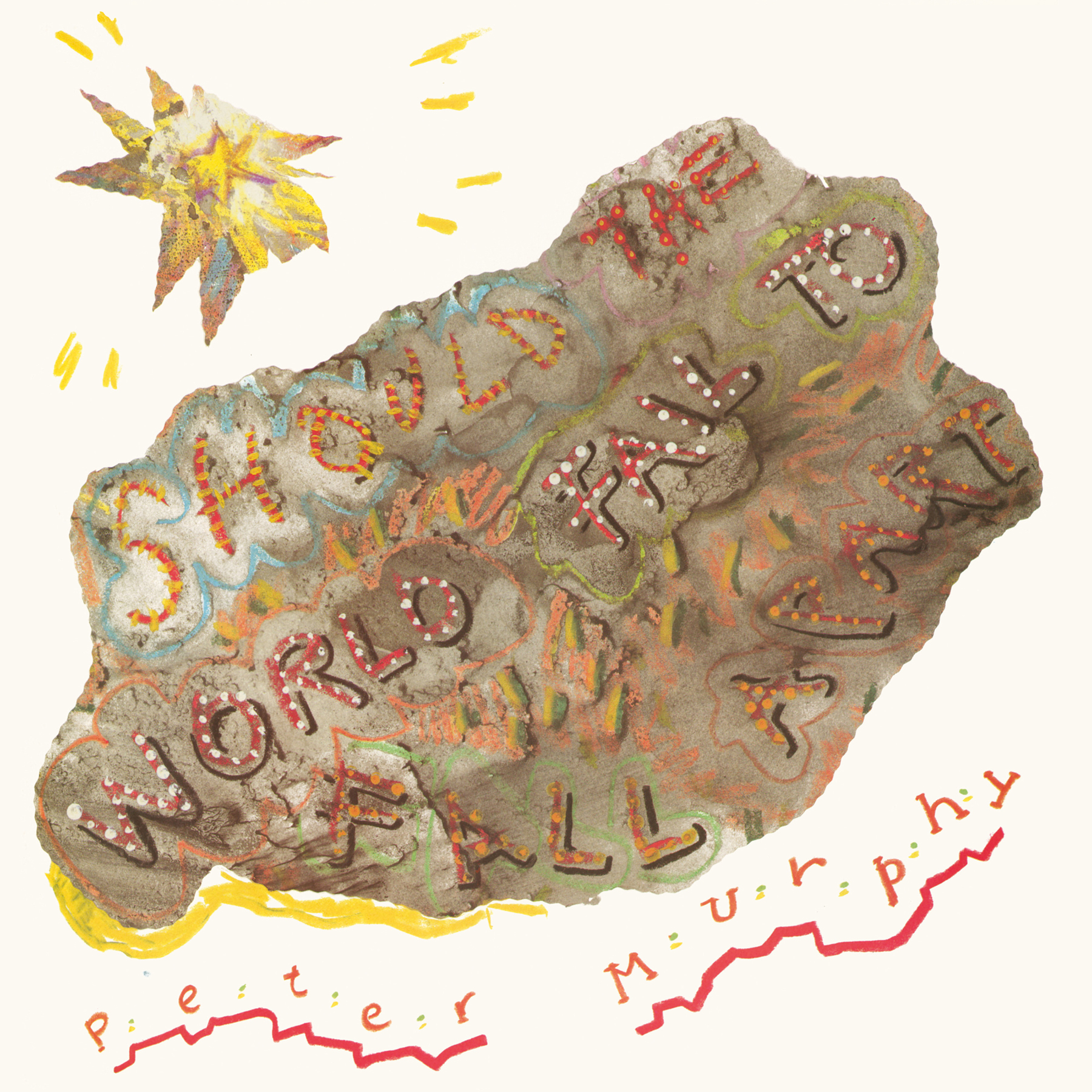 Should the World Fail to Fall Apart finds Murphy not entirely moving away from the entanglements of his former group, elaborating on the musical styles explored in Dalis Car. The musical stylings of his debut were problematic for me on its original release, enamored as I was of Bauhaus. Still, over the years, it has grown to become one of my personal favorites of his solo works despite it often being deemed one of his less worthy offerings. The album is reminiscent of a transition period, but the reissue is a reminder of his brilliance.
Should the World Fail to Fall Apart finds Murphy not entirely moving away from the entanglements of his former group, elaborating on the musical styles explored in Dalis Car. The musical stylings of his debut were problematic for me on its original release, enamored as I was of Bauhaus. Still, over the years, it has grown to become one of my personal favorites of his solo works despite it often being deemed one of his less worthy offerings. The album is reminiscent of a transition period, but the reissue is a reminder of his brilliance. This is the debut album from a Berlin-based foursome dedicated to performing the works of Malaysian-born composer/trombonist Rishin Singh. Notably, Singh is also a member of Konzert Minimal, which is a modern classical ensemble dedicated to performing compositions by the Wandelweiser collective. In a 2016 New Yorker profile of the Wandelweiser milieu, Alex Ross noted that one recurring theme in their work is a "ghost tonality never achieves stability; it will frustrate those who expect one chord to lead logically to another." Singh's own vision shares a lot of similar stylistic terrain, as A Fog Like Liars Loving is nothing if not ghostly (and creepy (and unsettling)). It resembles an alternate universe version of Low in which they were a chamber music ensemble that listened to a steady diet of nothing but Jandek, Scott Walker, Marble Index-era Nico, and warped old folk records played at the wrong speed. That said, Singh definitely has an unusually sophisticated sensibility regarding dissonant harmonies and the entire album has an eerily nocturnal, dread-soaked, and somnambulant feel that is uniquely Leider's own. Purportedly, the album also features an "understated gallows humor," which is also an achievement of sorts, as Singh has managed to cultivate a strain of black humor so bleak that even I often have a hard time detecting it.
This is the debut album from a Berlin-based foursome dedicated to performing the works of Malaysian-born composer/trombonist Rishin Singh. Notably, Singh is also a member of Konzert Minimal, which is a modern classical ensemble dedicated to performing compositions by the Wandelweiser collective. In a 2016 New Yorker profile of the Wandelweiser milieu, Alex Ross noted that one recurring theme in their work is a "ghost tonality never achieves stability; it will frustrate those who expect one chord to lead logically to another." Singh's own vision shares a lot of similar stylistic terrain, as A Fog Like Liars Loving is nothing if not ghostly (and creepy (and unsettling)). It resembles an alternate universe version of Low in which they were a chamber music ensemble that listened to a steady diet of nothing but Jandek, Scott Walker, Marble Index-era Nico, and warped old folk records played at the wrong speed. That said, Singh definitely has an unusually sophisticated sensibility regarding dissonant harmonies and the entire album has an eerily nocturnal, dread-soaked, and somnambulant feel that is uniquely Leider's own. Purportedly, the album also features an "understated gallows humor," which is also an achievement of sorts, as Singh has managed to cultivate a strain of black humor so bleak that even I often have a hard time detecting it. This latest release from Scott Morgan’s long-running loscil project is a bit of a conceptual detour from his usual fare, as the entire album was "sourced from a single three-minute composition performed by a 22-piece string orchestra in Budapest." That is not all, however, as that brave composition's unconventional journey also included an intermediate stage in which it was "lathe-cut on to a 7-inch, then 'scratched and abused to add texture and color.'" Despite those unusual origins, Clara still sounds exactly like a loscil album, as Morgan is nothing if not consistent. In this case, that basically translates as "a slow-motion dub techno album lurking behind a grayscale ambient fog," but the magic lies in the execution (as always) and Morgan has never been a slouch in that regard. In fact, he succeeds on two fronts with this release, as Clara is both another fine loscil album and an impressive feat of inventive de-/ re-construction, as Morgan managed to transform three minutes of music into a varied, absorbing, and dynamically satisfying album-length statement (and he made it all seem effortless and natural to boot).
This latest release from Scott Morgan’s long-running loscil project is a bit of a conceptual detour from his usual fare, as the entire album was "sourced from a single three-minute composition performed by a 22-piece string orchestra in Budapest." That is not all, however, as that brave composition's unconventional journey also included an intermediate stage in which it was "lathe-cut on to a 7-inch, then 'scratched and abused to add texture and color.'" Despite those unusual origins, Clara still sounds exactly like a loscil album, as Morgan is nothing if not consistent. In this case, that basically translates as "a slow-motion dub techno album lurking behind a grayscale ambient fog," but the magic lies in the execution (as always) and Morgan has never been a slouch in that regard. In fact, he succeeds on two fronts with this release, as Clara is both another fine loscil album and an impressive feat of inventive de-/ re-construction, as Morgan managed to transform three minutes of music into a varied, absorbing, and dynamically satisfying album-length statement (and he made it all seem effortless and natural to boot).